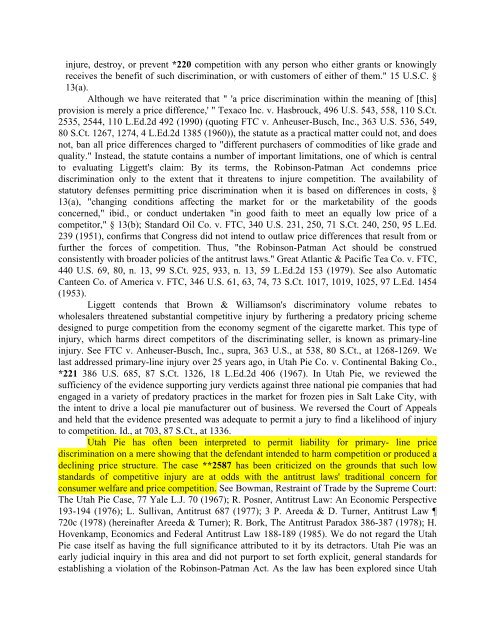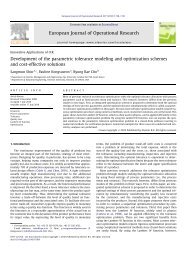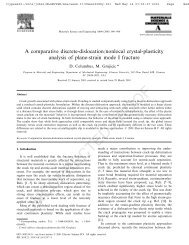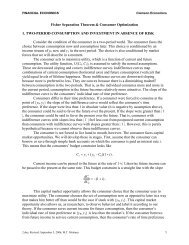509 U.S. 209, 113 S.Ct. 2578 BROOKE GROUP LTD., Petitioner v ...
509 U.S. 209, 113 S.Ct. 2578 BROOKE GROUP LTD., Petitioner v ...
509 U.S. 209, 113 S.Ct. 2578 BROOKE GROUP LTD., Petitioner v ...
Create successful ePaper yourself
Turn your PDF publications into a flip-book with our unique Google optimized e-Paper software.
injure, destroy, or prevent *220 competition with any person who either grants or knowingly<br />
receives the benefit of such discrimination, or with customers of either of them." 15 U.S.C. §<br />
13(a).<br />
Although we have reiterated that " 'a price discrimination within the meaning of [this]<br />
provision is merely a price difference,' " Texaco Inc. v. Hasbrouck, 496 U.S. 543, 558, 110 S.<strong>Ct</strong>.<br />
2535, 2544, 110 L.Ed.2d 492 (1990) (quoting FTC v. Anheuser-Busch, Inc., 363 U.S. 536, 549,<br />
80 S.<strong>Ct</strong>. 1267, 1274, 4 L.Ed.2d 1385 (1960)), the statute as a practical matter could not, and does<br />
not, ban all price differences charged to "different purchasers of commodities of like grade and<br />
quality." Instead, the statute contains a number of important limitations, one of which is central<br />
to evaluating Liggett's claim: By its terms, the Robinson-Patman Act condemns price<br />
discrimination only to the extent that it threatens to injure competition. The availability of<br />
statutory defenses permitting price discrimination when it is based on differences in costs, §<br />
13(a), "changing conditions affecting the market for or the marketability of the goods<br />
concerned," ibid., or conduct undertaken "in good faith to meet an equally low price of a<br />
competitor," § 13(b); Standard Oil Co. v. FTC, 340 U.S. 231, 250, 71 S.<strong>Ct</strong>. 240, 250, 95 L.Ed.<br />
239 (1951), confirms that Congress did not intend to outlaw price differences that result from or<br />
further the forces of competition. Thus, "the Robinson-Patman Act should be construed<br />
consistently with broader policies of the antitrust laws." Great Atlantic & Pacific Tea Co. v. FTC,<br />
440 U.S. 69, 80, n. 13, 99 S.<strong>Ct</strong>. 925, 933, n. 13, 59 L.Ed.2d 153 (1979). See also Automatic<br />
Canteen Co. of America v. FTC, 346 U.S. 61, 63, 74, 73 S.<strong>Ct</strong>. 1017, 1019, 1025, 97 L.Ed. 1454<br />
(1953).<br />
Liggett contends that Brown & Williamson's discriminatory volume rebates to<br />
wholesalers threatened substantial competitive injury by furthering a predatory pricing scheme<br />
designed to purge competition from the economy segment of the cigarette market. This type of<br />
injury, which harms direct competitors of the discriminating seller, is known as primary-line<br />
injury. See FTC v. Anheuser-Busch, Inc., supra, 363 U.S., at 538, 80 S.<strong>Ct</strong>., at 1268-1269. We<br />
last addressed primary-line injury over 25 years ago, in Utah Pie Co. v. Continental Baking Co.,<br />
*221 386 U.S. 685, 87 S.<strong>Ct</strong>. 1326, 18 L.Ed.2d 406 (1967). In Utah Pie, we reviewed the<br />
sufficiency of the evidence supporting jury verdicts against three national pie companies that had<br />
engaged in a variety of predatory practices in the market for frozen pies in Salt Lake City, with<br />
the intent to drive a local pie manufacturer out of business. We reversed the Court of Appeals<br />
and held that the evidence presented was adequate to permit a jury to find a likelihood of injury<br />
to competition. Id., at 703, 87 S.<strong>Ct</strong>., at 1336.<br />
Utah Pie has often been interpreted to permit liability for primary- line price<br />
discrimination on a mere showing that the defendant intended to harm competition or produced a<br />
declining price structure. The case **2587 has been criticized on the grounds that such low<br />
standards of competitive injury are at odds with the antitrust laws' traditional concern for<br />
consumer welfare and price competition. See Bowman, Restraint of Trade by the Supreme Court:<br />
The Utah Pie Case, 77 Yale L.J. 70 (1967); R. Posner, Antitrust Law: An Economic Perspective<br />
193-194 (1976); L. Sullivan, Antitrust 687 (1977); 3 P. Areeda & D. Turner, Antitrust Law <br />
720c (1978) (hereinafter Areeda & Turner); R. Bork, The Antitrust Paradox 386-387 (1978); H.<br />
Hovenkamp, Economics and Federal Antitrust Law 188-189 (1985). We do not regard the Utah<br />
Pie case itself as having the full significance attributed to it by its detractors. Utah Pie was an<br />
early judicial inquiry in this area and did not purport to set forth explicit, general standards for<br />
establishing a violation of the Robinson-Patman Act. As the law has been explored since Utah
















